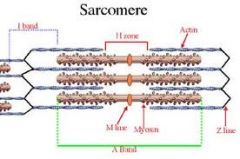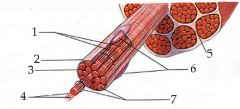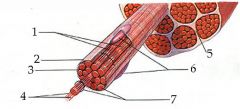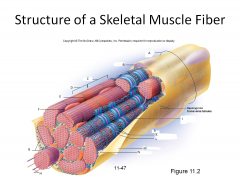![]()
![]()
![]()
Use LEFT and RIGHT arrow keys to navigate between flashcards;
Use UP and DOWN arrow keys to flip the card;
H to show hint;
A reads text to speech;
80 Cards in this Set
- Front
- Back
|
blood capillaries that supply the epidermis are located in the-
|
dermis
|
|
|
subcutaneous glands discharge an oily secretion called ______ that inhibits bacterial growth
|
sebum
|
|
|
which are correct concerning thick skin?
A. it is limited in its distribution than thin shin is B. it has only 4 of the strata C. it has sweat glands D. it has hair follicules E. both A and C are correct |
E. both A and C are correct
|
|
|
which of the following are true of the stratum corneum?
A. the cells are dead B. it is the most superficial stratum C. the cells lack nuclei D. All of the above are correct E. none of the above are correct |
D. All the Above
|
|
|
the function of melanin in the skin is to-
|
protect against UV light
|
|
|
subcutaneous fat (the fatty layer just beneath the skin) is also known as-
|
Adipose tissue
|
|
|
collagen fibers provide strength to skin while _______ fibers allow stretch and contraction in the dermis during movement.
|
elastic
|
|
|
when the body is too warm, dermal blood vessels will undergo ________ in order to increase heat loss
|
vasodialation
|
|
|
which one of the following is characteristic of cartilage connective tissue?
A. has a thick gel-like ground substance B. matrix may contain protein fibers C. contains cells called chondrocytes D. All of the above |
D. all the above
|
|
|
during the growth of cartilage, the cells that produce new matrix are the:
|
chondroblasts
|
|
|
which is not a function of bone?
A. protection B. mineral storage C. body movement D. support E. hemopoiesis |
C. body movement
|
|
|
when a muscle is isometrically contracted its length ____________ change
|
does not
|
|
|
which is not a function of cartilage?
A. provides support for certain soft tissues B. synthesizes red blood cells C. forms gliding surface at articulations D. serves as a model for bone formation E. no exceptions; all are functions |
B. synthesizes red blood cells
|
|
|
which type of cartilage is found in the intervetebral discs?
A. hyaline cartilage B. fibrocartilage C. reticular cartilage D. articular cartilage E. elastic cartilage |
B. fibrocrtilage
|
|
|
an example of a flat bone would be:
A. femur B. radius C. sacrum D. parietal E. atlas |
D. parietal
|
|
|
where does hemopoiesis occur?
|
yellow bone marrow
|
|
|
the outer layer if a long bone is covered with a layer of connective tissue called the
|
endosteum
|
|
|
cells that produce new bone tissue by secreting matrix are called-
|
osterprogenitor cells
|
|
|
in general, a skeletal muscle is composed of-
|
connective tissue, neural tissue, epithelial tissue, and muscular tissue
|
|
|
if a bone is immersed in a weak acid such as vinegar for several days, its organic components will dissolve. what will be the result of such an experiment?
|
the bone will become soft and flexible
|
|
|
in compact bone, the matrix rings that surround the central canal of each osteon are called-
|
lamellae
|
|
|
when muscle tension is greater than the resistance (weight) movement ______ occur-
|
will
|
|
|
which vitamin is required for the absorption of calcium in the intestines?
|
vitamin D
|
|
|
compact bone:
A. contains no lamellae B. is composed of tubular units called osteones C. is avascular D. all the above E. none of the above |
B. is composed if tubular units called osteones
|
|
|
top endurance runners probably have _________ proportion of slow muscle fibers in their leg muscle
|
a higher
|
|
|
what would be a effect on bone growth if a person had an insufficient dietary calcium intake?
|
the matrix would be softer
|
|
|
which is not true about bone remodeling?
A. it occurs throughout life B. is assists in the maintenance of calcium and phosphate levels in the body C. it occurs at both the endosteal and periosteal surfaces of the bone D. it occurs only at articular surfaces |
D. it occurs only at articulation surfaces
|
|
|
what organelle stores the calcium required for muscle contraction?
|
sarcoplasmic reticulum
|
|
|
spongy bone:
A. contains no ostercytes B. is composed of tubular units called trabeculae C. is superficial to compact bone D. all the above |
B. is composed if tubular units called trabeculae
|
|
|
which is the neurotransmitter that causes the release if calcium ions and initiates the steps of skeletal muscles fiber contraction?
|
actylcholine
|
|
|
correct chronological order if bone repair:
|
1. fracture hemotoma (clot) forms
2. fibrocartilaginous callus forms 3. bony callus forms 4. bone is remodeled |
|
|
trochanters, tubercles and tuberosities are bone marking that serve as:
|
attachments for ligaments or tendons
|
|
|
which is the correct order in the hierarchy of a skeletal muscles components, beginning with the smallest and ending with the largest?
A. myofibrils B. muscle fiber C. fasicle D. whole muscle |
a,b,c,d
|
|
|
which is the correct order in the hierarchy of the connective tissue layers in skeletal muscle, beginning with the outermost layer and ending with the innermost layer?
A. endomysium B. epimysium C. perimysium |
b,c,a
|
|
|
the structure responsible for attaching muscle to bone is a
|
a tendon
|
|
|
which protein makes up the thick filaments?
|
myosin
|
|
|
a motor unit consists of
|
a single motor neuron and the muscle fibers it is connected to
|
|
|
which tpye of muscle contraction occurs when you try to (unsuccessfully) move a wall?
|
isometric
|
|
|
a muscle whose name has "orbicularis" in it is ______ in appearance
|
circular
|
|
|
a muscle whose name has triceps in it has
|
three muscle heads or tendons of origin
|
|
|
where is the A band and Z-disc
|

|
|
|
the structural classification of joints is based upon whoch of the following:
A. presence or absence of fibrous tissue B.presence or absence of cartilage where the bones meet C. presence or absence of a fluid- filled cavity where bones join D. all the above |
D. all the above
|
|
|
which of the following is not a component of a typical synovial joint?
A. synovial membrne B. hyaline cartilage C. pericardium D joint cavity |
C. pericardium
|
|
|
rank the following articulations in decreasing order of stability:
A. intervatebral joints B. sutures C. glenohumeral joint (sholder) D. humeroulnar joint (hip) E. coxal joint (hip) |
c,e,d,a,b
|
|
|
which if the following does not contribute to skin color?
A. hemoglobin B. carotene C. melanin D. Vitamin D |
vitamin D
|
|
|
the superficial layer of the dermis containing dermal "nipples" is called the-
|
papillary layer
|
|
|
which of the following is not a normal step in the process of wound repair?
A. regeneration of the epidermis B. formation of granulation C. bleeding D. clotting E. fibrous |
fibrous
|
|
|
which of the following muscle groups is responsible for flexion of the leg?
A. the quadriceps B. the adductor group C. the gastrocemius D. the hamstrings E. the hip flexors |
the hamstrings
|
|
|
which of the following are not components of thin filaments?
A. actin B. troponin C. myosin D. tropomyosin |
troponin
|
|
|
place the events involved in muscle contraction on the correct order
A. a nerve impulse causes ACh release at a neurotransmitter junction B. ACh binds receptors on the motor end plates, intiating a muscles impulse C. myosin heads attach to form crossbridges D. calcium ions are released from the sarcoplasmic reticulum E. calcium ions bind to troponin, casuing tropomyosin to move and expose active sites |
a,b,d,e,c
|
|
|
in the gluteus maximus, each motor unit controls a(n) __________ amount of muscle fibers compared to a motor unit in the eye muscles
|
greater
|
|
|
know the anterior cruciate and the lateral meniscus
|

|
|

what does the number 2 denote
|
sarcolemma
|
|

what does the number 4 denote
|
myofiliments
|
|

what does the number 7 denote?
|
myofibril
|
|

what does "K" denote?
|
sarcoplasmic reticulum
|
|
|
true or false:
endochondral ossification is a form of bone growth in which a cartilaginous model is replaced by bone |
true
|
|
|
true or false:
further lengthwise bone growth cannot ouur once the epiphyseal line have formed |
true
|
|
|
true or false:
once we reach adulthood and out bones are fully formed and hardened, they cannot be remodeled |
false
|
|
|
true or false:
in the hierarchy of skeletal muscle fiber components, the myofibril is made up of mtofilaments |
true
|
|
|
true or false:
the energy to drive the myosin movement during skeletal muscle contraction is provided by ATP |
true
|
|
|
true or false:
smooth muscle tissue is found in the organs of the digestive tract and the walls if the blood vessels |
true
|
|
|
true or false:
skeletal muscle cells typically contain multiple nuclei |
true
|
|
|
true or false:
flexion of the are brings the hand closer to the shoulder |
false
|
|
|
true or false:
muscle relaxation is dependent upon the availability of ATP |
true
|
|
|
true or false:
the sarcomere is the smallest functional unit of skeletal muscle |
true
|
|
|
true or flase:
in the limbs, the insertion of a muscle typically lies proximal to its origin |
false
|
|
|
true or false
individual skeletal muscle fibers run the entire length of a muscle |
true
|
|
|
Accessory organs in the skin that release fluid onto the surface of the skin through a duct are properly referred to as __________ glands
|
exocrine
|
|
|
the neurons that stimulate muscle contraction are called ________ neurons
|
motor
|
|
|
endochondral ossification begins with a(n) _________ model
|
cartilage
|
|
|
friction ridges in thick skin are commonly referred to as ________ _________
|
finger prints
|
|
|
the humerus is an example of a(n) __________ bone
|
long
|
|
|
bone cells called___________ break down bone by secreting hydochloric acid and enzymes that dissolve the matrix
|
osteoclasts
|
|
|
lines of _________ indicate the predominant of the underlying collagen fibers in the reticular layer of the dermis
|
cleavage
|
|
|
the protein responsible for storing oxygen within skeletal muscle is called _________________
|
myoglobin
|
|
|
a sarcomere is defined as the distance from one ________ to the next adjacent ________ (the same answer fills in both spaces)
|
Z-disc
|
|
|
the type of muscle that is under involentary control, is striated, and has junctions called intercalated discs is called ____________ muscle
|
cardiac
|
|
|
define rigor mortis and explain the molecular mechanisms that cause rigor mortis
|
Rigor Mortis means stiffness after death. Rigor mortis is caused by the leakage of calcium ions from the sarcoplasmic reticulum after death. The calcium ions bind to the troponin complex which moves the tropomyosin complex off of the actin thin filaments allowing the myosin heads to bind to the thin filaments. The myosin heads undergo one round of contraction and remain attached to the actin filaments because ATP is not present to release the cross-bridges.
|
|
|
explain how the chemical weapon VX affects neuromuscular junctions
|
The chemical weapon affects the neuromuscular junction by inhibiting the enzyme acetylcholinesterase. This prevents the breakdown of acetylcholine and causes a continuous stimulation (depolarization) of the post-synaptic membrane.
|

